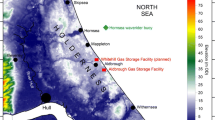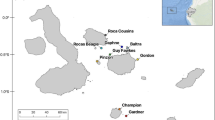Abstract
The benthic macrofauna and physical features of 10 sandy beaches along the coast of Oman were surveyed quantitatively. This is a mesotidal regime mostly subject to low to moderate wave energy but more exposed in the south. Five northern beaches are tide-dominated, with low wave energy, and their profiles consist of a berm, a steep, swash-dominated upper shore and a broad tide-dominated terrace from mid-shore downwards. They are composed of moderately sorted fine to medium sands. Southern beaches experience greater wave energy, particularly during the summer southwest monsoon, and exhibit smoother, concave profiles with fine, fairly well sorted carbonate sand. 58 species and species groups were recorded, with crustanceans, polychaetes and molluscs dominant. In general species richness was high, at least 19–25 species per beach, but dry biomass moderate to low at 26–90g/m shoreline, with one high value of 450g/m. Total abundance was moderate at 3–73×103 organisms/m of beach. Some zonation was evident with ocypodid crabs andTylos in the supralittoral, cirolanid isopods on the upper shore and a variety of species on the lower shore. The coast of Oman appears to constitute a single zoogeographic region, but with some regional differentiation between north and south due to varying physical conditions. Thus, OmanÕs beaches are characterized by tide-dominated morphodynamics and exceptionally high species richness.
Similar content being viewed by others
Abbreviations
- BSI:
-
Beach State Index
References
Anon. 1986–1991.Oman coastal zone management plan (5 parts). IUCN, Gland.
Ansell, A.D. 1980.The beach at Qurm. Oman Observer, Muscat.
Bosch, D.T., Dance, S.P., Molenbeeck, R.G. & Oliver, P.G. 1996.Seashells of Eastern Arabia. Motivate Publishing, Dubai.
Clayton, D.A. 1996. Ghost crabs of Oman (Crustacea: Brachyura: Ocypodidae).Sultan Quaboos Univ. J. Sci. 1: 27–35.
Coles, S.L. & Al-Riyami, K.A. 1996. Beach tar concentrations on the Muscat coastline, Gulf of Oman, Indian Ocean, 1993–1995.Mar. Poll. Bull. 32: 609–614.
Folk, R.L. 1974.Petrology of sedimentary rocks. Hemphill, Austin, TX.
Gibbs, R.J., Mathews, M.D. & Link, D.A. 1971. The relationship between sphere size and settling velocity.J. Sedim. Petrol. 41: 7–18.
Hill, M. O. 1979a.TWINSPAN: A FORTRAN program for arranging multivariate data in an ordered two-way table by classification of the individuals and attributes. Cornell University, Ithaca, NY.
Hill, M.O. 1979b.DECORANA: A FORTRAN program for detrended correspondence analysis and reciprocal averaging. Cornell University, Ithaca, NY.
Jaramillo, E., McLachlan, A. & Coetzee, P. 1993. Intertidal zonation patterns of macrofauna over a range of exposed sandy beaches in South-Central Chile.Mar. Ecol. Progr. Ser. 101: 105–118.
Jaramillo, E., McLachlan, A. & Dugan, J. 1995. Total sample area and estimates of species richness in exposed sandy beaches.Mar. Ecol. Progr. Ser. 119: 311–314.
Jongman, R.H.G., ter Braak, C.J.F. & van Tongeren, O.F.R. 1995.Data analysis in community and landscape ecology. Cambridge University Press, Cambridge
McLachlan, A. & Jaramillo, E. 1995. Zonation on sandy beaches.Oceanogr. Mar. Biol. Annu. Rev. 33: 305–335.
McLachlan, A., Jaramillo, E., Donn, T.E. & Wessels, F. 1993. Sandy beach macrofauna communities and their control by the physical environment: a geographical comparison.J. Coastal Res. SI 15: 27–38.
McLachlan, A., de Ruyck, A.M.C. & Hacking, N. 1997. Community structure on sandy beaches: patterns of richness and zonation in relation to tide range and latitude.Rev. Chilena 69-451-468.
McLain, J.C. 1984. Marine ecology of Saudi Arabia. The intertidal infauna of the sand beaches in the northern area, Arabian Gulf, Saudi Arabia.Fauna of Saudi Arabia 6: 53–78.
Salm, R.V., Jensen, R.A.C. & Papastavrou, V.A. 1993.Marine fauna of Oman Cetaceans, turtles, seabirds, & shallow water corals. IUCN, Gland.
Sheppard, C.R.C., Price, A.R.G. & Roberts, C. 1992. Marine ecology of the Arabian region: patterns and processes in extreme tropical environments. Academic Press, London.
Short, A.D. 1997. Overview of sandy beach morphodynamics.Rev. Chilena 69: 589–604.
ter Braak, C.J.F. 1986. Canonical correspondence analysis: a new eigenvector technique for multivariate direct gradient analysis.Ecology 67: 1167–1179.
Tÿrkay, M., Sakai, K. & Apel, M. 1996. TheOcypode ghost crabs (Crustacea: Decapoda: Brachyura) of the Arabian Peninsula and adjacent regions.Fauna of Saudi Arabia 15: 99–117.
Author information
Authors and Affiliations
Corresponding author
Rights and permissions
About this article
Cite this article
McLachlan, A., Fisher, M., Al-Habsi, H.N. et al. Ecology of sandy beaches in Oman. J Coast Conserv 4, 181–190 (1998). https://doi.org/10.1007/BF02806510
Received:
Revised:
Accepted:
Issue Date:
DOI: https://doi.org/10.1007/BF02806510




